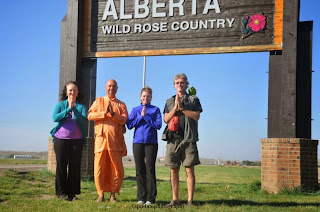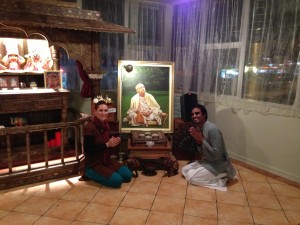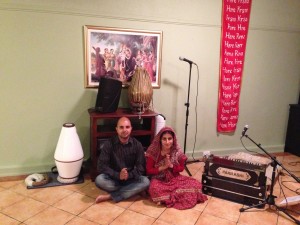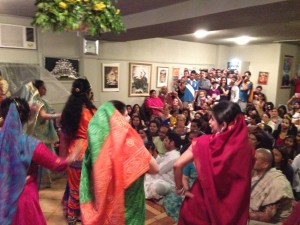(Kadamba Kanana Swami, 11 September 2013, Durban, South Africa, Srimad Bhagavatam 1.3.38)
 There is a part in us that does not want to surrender. That is the lazy part; it is a fight with the mind. Laziness is an affliction of the modes of ignorance and one has to fight the mode of ignorance by acting according to a proper standard. Out of laziness, when something is not a hundred percent clean then we may say, “I’ll clean it tomorrow.” But no, it must be done now!
There is a part in us that does not want to surrender. That is the lazy part; it is a fight with the mind. Laziness is an affliction of the modes of ignorance and one has to fight the mode of ignorance by acting according to a proper standard. Out of laziness, when something is not a hundred percent clean then we may say, “I’ll clean it tomorrow.” But no, it must be done now!
So, by determination, one has to try and conquer this laziness. For laziness, there is no easy cure. A lazy man, because he is lazy, does not want to take the cure himself. He thinks, “Isn’t there a cure; something easy where I don’t have to do anything and I can just get rid of my laziness.”
No! Actually, one has to work to overcome laziness. That is the only solution, by doing something. Therefore we must take responsibility in devotional service because it forces a lazy person not to be lazy. Sometimes, they say that I was in charge of the samadhi construction in Mayapur and did all that. To be honest, I didn’t want to do it but they told me to do it! I still didn’t want to do it but I did it and when I was doing it, I was thinking, “I don’t want to do this.” But what to do, I was forced to do it. So, taking responsibility helps to overcome our laziness and our independent mind that doesn’t want to surrender.
 Vaisesika Prabhu organized the distribution of twenty-two thousand five hundred books during Ratha Yatra. The books were put in plastic bags along with other items and passed out along the parade route and at the festival grounds
Vaisesika Prabhu organized the distribution of twenty-two thousand five hundred books during Ratha Yatra. The books were put in plastic bags along with other items and passed out along the parade route and at the festival grounds  Ilford, East London Ratha Yatra, 22nd September 2013
Ilford, East London Ratha Yatra, 22nd September 2013  We are each born with specific gifts, work that comes naturally to us and that we do well. The perfection of engaging these gifts, according to scriptural injunctions, is for the pleasure of Krishna. This not only pleases Krishna, the Supreme Personality, but is also the means for achieving our own personal happiness
We are each born with specific gifts, work that comes naturally to us and that we do well. The perfection of engaging these gifts, according to scriptural injunctions, is for the pleasure of Krishna. This not only pleases Krishna, the Supreme Personality, but is also the means for achieving our own personal happiness  Bhaktivedanta Academy Gurukula's mission is to provide a facility for the Academy's members to study, practice, and disseminate the teachings of Srimad Bhagavatam, along with corollary studies of the standard works of the Gaudiya Vaisnava acaryas and the branches of Vedic philosophy, culture, and science in the context of Srimad Bhagavatam and Srila Prabhupada’s teachings
Bhaktivedanta Academy Gurukula's mission is to provide a facility for the Academy's members to study, practice, and disseminate the teachings of Srimad Bhagavatam, along with corollary studies of the standard works of the Gaudiya Vaisnava acaryas and the branches of Vedic philosophy, culture, and science in the context of Srimad Bhagavatam and Srila Prabhupada’s teachings  The Bhaktivedanta Cultural Center features an extraordinary exhibit of India's timeless heritage with a magnificient traditional Vedic Temple and an elaborate multimedia presentation combining exquisite sculptures with state of the art audio visual technology
The Bhaktivedanta Cultural Center features an extraordinary exhibit of India's timeless heritage with a magnificient traditional Vedic Temple and an elaborate multimedia presentation combining exquisite sculptures with state of the art audio visual technology 





















































 Dallas Morning News,
Dallas Morning News,



 The vivaha-samskara (wedding rite) offers an excellent opportunity to spiritualize thoughts, emotions, and commitments that accompany being united with one's chosen partner. A Vaishnava wedding (a wedding of devotees of Krishna) is not only a colorful, joyful ceremony but also a source of devotional inspiration for years to come. When difficulties arise in the relationship, we may ask ourselves, "How did I get into this situation? Why did I marry this person?" Then the mind will go back to the wedding day and automatically remember Lord Krishna, His devotees, and His loving service.
The vivaha-samskara (wedding rite) offers an excellent opportunity to spiritualize thoughts, emotions, and commitments that accompany being united with one's chosen partner. A Vaishnava wedding (a wedding of devotees of Krishna) is not only a colorful, joyful ceremony but also a source of devotional inspiration for years to come. When difficulties arise in the relationship, we may ask ourselves, "How did I get into this situation? Why did I marry this person?" Then the mind will go back to the wedding day and automatically remember Lord Krishna, His devotees, and His loving service.  The Dead Sea, also called the Salt Sea, is a salt lake bordering Jordan to the east and Israel and Palestine to the west. Its surface and shores are 423 metres below sea level
The Dead Sea, also called the Salt Sea, is a salt lake bordering Jordan to the east and Israel and Palestine to the west. Its surface and shores are 423 metres below sea level  This ceremony is held every evening before sunset to please Sri Yamuna Devi, at Kesi ghat, Parikrama path, Vrindavan, Uttarpradesh, India. Sri Yamuna Maharani Ki Jaya ! Sri Radharani Ki Jaya!
This ceremony is held every evening before sunset to please Sri Yamuna Devi, at Kesi ghat, Parikrama path, Vrindavan, Uttarpradesh, India. Sri Yamuna Maharani Ki Jaya ! Sri Radharani Ki Jaya! 


 Indradyumna Swami: Already 6,000 devotees have arrived at an old resort on the Black Sea for ISKCON Russia's annual Sadha Sanga Festival. More are expected over the next few days
Indradyumna Swami: Already 6,000 devotees have arrived at an old resort on the Black Sea for ISKCON Russia's annual Sadha Sanga Festival. More are expected over the next few days 
